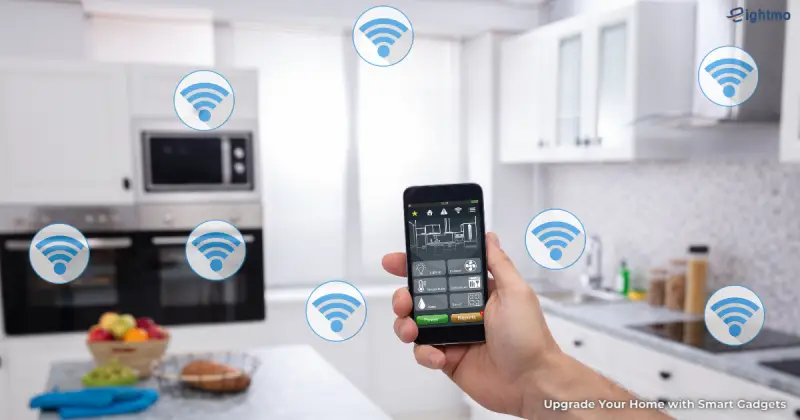Want to learn the pros and cons of smart home? Imagine waking up in the morning and your coffee is already brewed, the lights gently brighten to ease you into the day, and the thermostat adjusts to the perfect temperature—all without lifting a finger. This is the promise of a smart home. The integration of smart appliances and gadgets into our living spaces is transforming the way we interact with our homes. But is this upgrade worth it?
As enticing as smart homes sound, they come with their own set of challenges. From privacy concerns to the hefty upfront costs, it’s essential to weigh the pros and cons before diving into the world of smart home technology. This article will explore the benefits and drawbacks of smart homes, helping you make an informed decision about whether this high-tech lifestyle is right for you.
Why You Should Upgrade to a Smart Home
1. Future-Proofing Your Home
As technology continues to advance, smart homes are likely to become the standard. Upgrading now ensures your home is future-ready:
- Increasing Home Value: Smart home features can make your property more attractive to potential buyers, potentially increasing its market value. Prospective buyers are often drawn to homes with the latest technology, as it promises convenience, security, and efficiency. Features such as smart security systems, automated climate control, and integrated smart appliances are seen as modern amenities that can differentiate your property from others on the market. Studies have shown that homes with smart technology can sell faster and at higher prices, as buyers are willing to pay a premium for these advanced features.
- Adaptability: As more devices and systems become interconnected, having a smart home will allow you to seamlessly integrate new technologies as they emerge. Investing in a smart home infrastructure now means you’ll be well-positioned to incorporate future innovations without needing major overhauls. For example, a home equipped with a robust smart home hub and compatible devices can easily add new gadgets, such as advanced AI-driven assistants or next-generation security features, without significant disruption. This adaptability ensures that your home remains cutting-edge and can evolve with technological advancements, providing long-term benefits and maintaining relevance in an increasingly tech-driven world.
2. Enhanced Lifestyle and Comfort
Smart homes offer a level of convenience and comfort that traditional homes simply can’t match:
- Time-Saving: Automating routine tasks frees up time for more important activities, enhancing your overall quality of life. With smart home technology, mundane chores like adjusting the thermostat, turning off lights, or watering plants can be handled automatically, leaving you with more time to focus on work, hobbies, or spending time with loved ones. For example, imagine waking up to a house that’s already warmed to your preferred temperature, or returning home to find that your lawn has been watered and your favorite music is playing—all without you having to lift a finger. These time-saving features can significantly reduce stress and improve your daily productivity.
- Personalization: Customize your home environment to perfectly match your lifestyle, whether it’s through personalized lighting, climate control, or entertainment systems. Smart home technology allows you to tailor your living spaces to your preferences with ease. For instance, you can create different lighting scenes for different activities, such as bright lights for cooking or dimmed lights for movie nights. Similarly, smart thermostats can learn your temperature preferences and adjust accordingly, ensuring optimal comfort throughout the day. Personalized entertainment systems, such as multi-room audio setups or home theater configurations, allow you to enjoy immersive experiences tailored to your tastes. This level of personalization enhances your daily comfort and enjoyment of your living spaces, creating a truly customized home environment.
3. Security and Peace of Mind
The enhanced security features of smart homes provide peace of mind, knowing your home is protected:
- Real-Time Monitoring: Keep an eye on your home from anywhere in the world, ensuring you’re always in control. With smart security cameras and sensors, you can access live feeds and check in on your home remotely using your smartphone or tablet. Whether you’re at work, on vacation, or simply out running errands, you can monitor activity in and around your home in real time. This constant surveillance allows you to respond promptly to any suspicious activity, ensuring the safety of your property and loved ones.
- Immediate Alerts: Receive instant notifications if something is amiss, allowing you to take swift action to protect your home and family. Smart home security systems can send alerts to your smartphone or other connected devices the moment they detect unusual activity, such as motion outside your front door or a window being opened unexpectedly. These alerts enable you to respond immediately, whether by contacting authorities, remotely activating alarms or lights, or simply checking the live camera feed to assess the situation. This rapid response capability can deter potential intruders and minimize the risk of damage or loss in the event of a security breach.
4. Eco-Friendly Living
Smart homes promote sustainable living by optimizing energy use:
- Reduced Carbon Footprint: By minimizing energy waste, smart homes contribute to environmental conservation. Smart devices, such as thermostats, lighting systems, and appliances, are designed to operate more efficiently, reducing unnecessary energy consumption. For example, smart thermostats can learn your schedule and adjust heating and cooling settings accordingly, ensuring rooms are only heated or cooled when necessary. Similarly, smart lighting systems can automatically dim or turn off lights in unoccupied rooms, preventing energy waste. These energy-saving features help reduce greenhouse gas emissions and lessen the overall environmental impact of home energy consumption.
- Cost Savings: Lower energy bills are a direct benefit of more efficient energy use, helping to offset the initial costs of smart home devices. While there may be upfront expenses associated with upgrading to smart technology, the long-term savings on energy bills can make it a financially savvy investment. By optimizing energy use and reducing waste, smart homes can significantly lower utility costs over time. For example, studies have shown that smart thermostats alone can save homeowners up to 15% on heating and cooling costs. Additionally, many utility companies offer incentives or rebates for installing energy-efficient devices, further enhancing the cost-effectiveness of smart home upgrades.
Exploring the Pros and Cons of Smart Home Upgrade
The Pros of Smart Homes
1. Convenience and Automation
One of the most significant advantages of smart homes is the convenience they offer. Imagine controlling all your home devices through a single app on your smartphone or using voice commands. Here are some ways smart home devices can simplify your life:
- Voice Control: With voice assistants like Amazon Alexa, Google Assistant, or Apple’s Siri, you can control your lights, appliances, and more with simple voice commands. Whether you’re adjusting the thermostat, playing your favorite song, or even ordering groceries, a simple “Alexa, do this” or “Hey Google, do that” makes life easier. This feature is particularly beneficial for those with limited mobility, as it offers hands-free control over various home functions.
- Automated Routines: Set routines for your daily activities. For instance, program your lights to turn off when you leave the house or have your thermostat adjust itself based on your schedule. Morning routines can include gradually increasing the light intensity, starting your coffee maker, and reading out your schedule for the day. Evening routines might involve dimming the lights, locking doors, and adjusting the thermostat for optimal sleeping conditions. These routines can be customized for weekdays, weekends, or special occasions, adding a layer of personalized automation to your life.
- Remote Access: Control and monitor your home from anywhere. Forgot to turn off the oven? You can do it remotely via your smartphone. This feature is incredibly useful for frequent travelers or those with busy schedules. Whether you’re at work, on vacation, or simply out for a walk, you can check on and control your home devices. For example, if you’re coming home early from a trip, you can preheat your home, turn on the lights, and even start your favorite playlist to welcome you back.
2. Energy Efficiency
Smart home devices can help reduce energy consumption, which is not only good for the environment but also for your wallet. Here’s how:
- Smart Thermostats: Devices like the Nest Learning Thermostat can learn your habits and adjust the temperature accordingly, ensuring you’re not wasting energy when you’re not home. These thermostats can also provide detailed energy reports, showing you exactly where you can save more energy. For example, by analyzing your usage patterns, they might suggest turning down the heating at night or when you’re away, significantly reducing your energy bills.
- Energy Monitoring: Smart plugs and other devices can track energy usage, helping you identify and reduce power-hungry appliances. With real-time data on how much energy each device consumes, you can make informed decisions about which appliances to use less frequently or upgrade to more energy-efficient models. Some systems also allow you to set limits on energy usage, automatically turning off devices that exceed your predetermined thresholds.
- Smart Lighting: Use motion sensors and automated schedules to ensure lights are only on when needed, cutting down on unnecessary energy use. For instance, lights can automatically turn off when no motion is detected for a certain period or dim during daylight hours to save electricity. Additionally, smart bulbs often have energy-efficient LEDs, which consume less power and last longer than traditional incandescent bulbs. This not only reduces energy consumption but also lowers the frequency of bulb replacements.
3. Enhanced Security
Security is a major concern for any homeowner, and smart home technology can significantly enhance your home’s safety. Key features include:
- Smart Locks: These allow you to lock and unlock your doors remotely, provide temporary access codes for guests, and even track who enters and exits your home. With smart locks, you no longer need to worry about losing your keys or hiding spare keys under the mat. You can also receive notifications when someone uses their code, so you know exactly when your children arrive home from school or when a maintenance worker has completed a job.
- Security Cameras: Indoor and outdoor cameras offer live feeds and notifications if they detect unusual activity. Some systems even include facial recognition and other advanced features. These cameras can be integrated with your smartphone, allowing you to check on your home at any time. Advanced features like facial recognition can identify familiar faces, reducing false alarms and providing you with a higher level of security. Some cameras also come with two-way audio, enabling you to communicate with visitors or deter intruders directly.
- Alarm Systems: Integrate with other smart devices to automatically trigger alarms and notify you and authorities in case of a break-in. These systems can be customized to cover all entry points of your home and can be armed or disarmed remotely. In the event of an intrusion, the system can send instant alerts to your phone and local law enforcement. Additionally, smart alarm systems can be programmed to activate lights, cameras, and other devices to create a comprehensive and automated response to any security breach.
4. Improved Comfort and Customization
Smart homes can adapt to your lifestyle, offering personalized comfort. Examples include:
- Smart Speakers: Enjoy high-quality audio throughout your home, controlling your music and media with voice commands. With devices like Amazon Echo or Google Home, you can play music in any room, create multi-room audio setups, and control playback with simple voice commands. Smart speakers can also read audiobooks, provide news updates, and answer questions, adding a versatile, hands-free experience to your daily life. Additionally, they can integrate with other smart home devices, allowing you to control lighting, thermostats, and security systems through voice commands.
- Automated Climate Control: Beyond thermostats, smart vents and fans can further refine your home’s climate, ensuring every room is just right. Smart vents can open and close to direct airflow where it’s needed most, while smart fans can adjust their speed based on the room’s temperature. For example, if a room is too warm, the smart system can activate ceiling fans to cool it down or redirect cool air from other parts of the house. This ensures a consistent and comfortable temperature throughout your home, reducing the need for manual adjustments and improving overall energy efficiency.
- Customizable Lighting: Create the perfect ambiance with smart bulbs that adjust color and brightness to suit your mood or activity. Smart lighting systems, like Philips Hue or LIFX, allow you to change the color and intensity of your lights with an app or voice command. You can set different scenes for various activities, such as a warm, dimmed setting for movie nights or bright, cool lighting for working or reading. Smart lighting can also be programmed to sync with your daily routine, gradually brightening in the morning to simulate sunrise or dimming in the evening to promote relaxation and better sleep.
The Cons of Smart Homes
1. High Initial Costs
The cost of setting up a smart home can be significant. Consider the following expenses:
- Devices: High-quality smart gadgets often come with a hefty price tag. A smart thermostat might cost several hundred dollars, and comprehensive security systems can be even more expensive. For instance, a top-tier smart security system including cameras, sensors, and alarms can easily exceed $1,000. Additionally, integrating various smart devices such as smart refrigerators, washing machines, and home entertainment systems can quickly add up, making the initial investment quite substantial.
- Installation: While many devices are DIY-friendly, some require professional installation, adding to the cost. Complex systems, like wired security systems or advanced home automation setups, often need a professional touch to ensure proper installation and functionality. Professional installation fees can vary widely depending on the complexity of the system and the rates of the service providers in your area. For example, installing a smart thermostat might cost $100-$200, while a full home automation system could require several days of work and incur higher costs.
- Upgrades and Maintenance: Technology evolves rapidly, and keeping your system up-to-date can be costly. New features and enhancements often come with software updates, but hardware updates might be necessary to leverage the full potential of your smart home. This means periodically replacing older devices with newer models, which can be an ongoing expense. Moreover, some smart devices require regular maintenance to function optimally. For instance, security systems might need periodic checks to ensure all sensors and cameras are working correctly, and smart lighting systems might need occasional recalibration. These upgrades and maintenance activities ensure your smart home remains efficient and secure but can add to the overall cost over time.
2. Privacy Concerns
With great convenience comes great responsibility, especially regarding your data. Smart home devices often collect and share data, raising privacy issues:
- Data Collection: Many devices collect data on your habits and routines. While this data can enhance functionality, it also poses privacy risks. For instance, smart thermostats learn your schedule to optimize heating and cooling, while smart speakers record voice commands to improve voice recognition. This collected data can reveal detailed information about your daily life, such as when you are home, your energy consumption patterns, and even your preferences for certain products or services. Although this data can make your smart home more efficient and tailored to your needs, it also creates a detailed profile that could be exploited if accessed by unauthorized parties.
- Hacking Risks: Any device connected to the internet is potentially vulnerable to hacking. Security breaches can lead to unauthorized access to your home or personal data. For example, if a hacker gains control of your smart lock, they could potentially unlock your door remotely. Similarly, compromised security cameras could provide intruders with real-time information about your home’s security setup and your whereabouts. Ensuring that all devices have robust, regularly updated security measures is crucial to mitigating these risks, but the possibility of hacking remains a significant concern.
- Third-Party Access: Some smart home companies may share data with third parties for marketing or other purposes, potentially compromising your privacy. This could include sharing information about your product usage, purchasing habits, and even personal behaviors with advertisers and other businesses. While this data sharing is often outlined in the privacy policies of smart home device manufacturers, many users may not fully understand the extent of data sharing. This third-party access can lead to targeted advertising and other invasions of privacy, making it important to carefully review and understand privacy policies before integrating new smart devices into your home.
3. Compatibility Issues
Smart home ecosystems are not always compatible with each other, which can lead to frustration:
- Different Brands: Devices from different brands may not work seamlessly together, requiring multiple apps and complicating the user experience. For instance, you might have a smart thermostat from one brand, a security camera from another, and smart lights from a third. Each of these devices might require its own app for control and management, leading to a cluttered and fragmented user experience. This fragmentation can make it difficult to create integrated routines and automations, as coordinating between different platforms can be cumbersome and inefficient.
- Standards and Protocols: Various smart home standards (like Zigbee, Z-Wave, or Wi-Fi) can create compatibility challenges. Ensuring all your devices work together can be tricky. For example, a device that uses Zigbee might not communicate with one that uses Z-Wave, and both might have limited compatibility with Wi-Fi-based devices. This necessitates the use of hubs or bridges to link different protocols, adding another layer of complexity and potential expense. Understanding the compatibility requirements of each device and choosing ones that operate on the same standard can help streamline your smart home setup, but it often requires careful planning and research.
- Future-Proofing: As technology evolves, older devices may become obsolete or incompatible with new systems, requiring frequent updates or replacements. For example, a smart light bulb purchased today might not support the new features of a smart home system released in a few years. This can lead to additional costs and the inconvenience of upgrading devices to maintain compatibility and access new functionalities. Manufacturers might also stop supporting older models, leaving them vulnerable to security risks or functional issues. To mitigate this, consider investing in devices from reputable brands known for providing long-term support and frequent updates.
By carefully considering these compatibility issues and planning your smart home ecosystem with an eye toward future developments, you can minimize frustration and create a more cohesive and reliable smart home experience.
4. Dependency on Technology
Relying heavily on smart devices can create potential problems:
- Technical Issues: Like all technology, smart devices can malfunction or fail, leading to inconvenience or even safety concerns. For instance, a smart lock that malfunctions might lock you out of your home, or a smart thermostat failure could leave your home too cold or too hot. These malfunctions can be more than just inconvenient—they can also pose safety risks. To mitigate these issues, it’s essential to have a backup plan, such as keeping physical keys for smart locks or maintaining manual controls for thermostats.
- Internet Dependence: Many smart home devices rely on a stable internet connection. If your Wi-Fi goes down, you could lose control over your home’s critical functions. For example, if your internet service is interrupted, you might be unable to adjust your thermostat, control your lighting, or access security cameras remotely. This reliance on internet connectivity makes having a robust and reliable internet service essential. Additionally, considering devices that offer local control options or having a backup internet source, like a mobile hotspot, can help maintain functionality during outages.
- Learning Curve: Not everyone is tech-savvy. The initial setup and learning how to use smart home devices effectively can be daunting for some users. Setting up a smart home system often involves navigating various apps, configuring devices, and integrating them into a cohesive network, which can be overwhelming for those unfamiliar with technology. Additionally, keeping up with updates and troubleshooting issues requires a certain level of technical knowledge. Providing comprehensive tutorials, seeking professional installation, and starting with simpler devices can help ease the learning curve for new users.
Contribute to a more sustainable future
The decision to upgrade your home with smart gadgets and appliances depends on your individual needs and circumstances. The convenience, security, and energy efficiency offered by smart homes are compelling reasons to embrace this technology. However, it’s essential to consider the potential downsides, such as high costs, privacy concerns, and compatibility issues.
Ultimately, smart homes represent a significant shift in how we interact with our living spaces. By carefully weighing the pros and cons, you can make an informed decision about whether a smart home is right for you. As technology continues to evolve, the advantages of smart home living are likely to increase, making now a great time to start exploring this exciting frontier.
With the right approach, a smart home can enhance your lifestyle, provide peace of mind, and contribute to a more sustainable future. The choice is yours, and the possibilities are endless.







